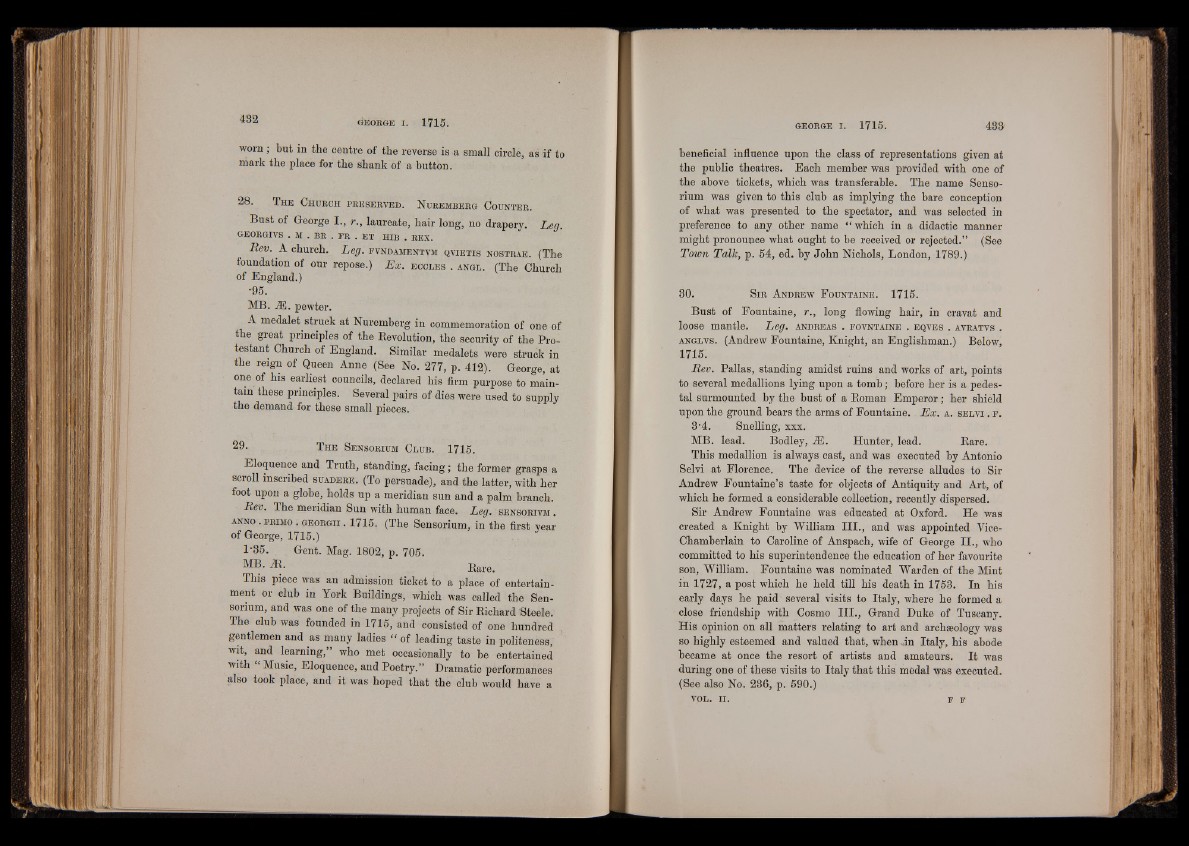
worn ; but in the centre of the reverse is a small circle, as if to
mark the place for the shank of a button.
28. T h e C h u r c h p r e s e r v e d . N u r em b e r g C o u n t e r .
Bust of George I., r., laureate, hair long, no drapery. Leg.
GEORGTVS . M . BR . FR . ET HIB . REX.
Rev. A church. Leg. fv n d am en tvm q v ie t is n o s t r a e . (The
foundation of our repose.) Ex. e c c l e s . a n g l . (The Church
of England.)
*^5.
MB. M. pewter.
A medalet struck at Nuremberg in commemoration of one of
the great principles of the Revolution, the security of the Protestant
Church of England. Similar medalets were struck in
the reign of Queen Anne (See No. 277, p. 412). George, at
one of his earliest councils, declared his firm purpose to maintain
these principles. Several pairs of dies were used to supply
the demand for these small pieces.
T h e S ensorxum C l u b . 1 7 1 5 .
Eloquence and Truth, standing, facing; the former grasps a
scroll inscribed s u a d e r e . (T o persuade), and the latter, with her
foot upon a globe, holds up a meridian sun and a palm branch.
Rev. The meridian Sun with human face. Leg. s e n s o r iv m .
anno . p r im o . g e o r g i i . 1715. (The Sensorium, in the first year
of George, 1715.)
1-35. Gent. Mag. 1802, p. 705.
MB- Rare.
This piece was an admission ticket to a place of entertainment
or club in York Buildings, which was called the Sensorium,
and was one of the many projects of Sir Richard Steele.
The club was founded in 1715, and consisted of one hundred
gentlemen and as many ladies " of leading taste in politeness,
wit, and learning,” who met occasionally to be entertained
with “ Music, Eloquence, and Poetry.” Dramatic performances
also took place, and it was hoped that the club would have a
beneficial influence upon the class of representations given at
the public theatres. Each member was provided with one of
the above tickets, which was transferable. The name Sensorium
was given to this club as implying the bare conception
of what was presented to the spectator, and was selected in
preference to any other name “ which in a didactic manner
might pronounce what ought to be received or rejected.” (See
Town Talk, p. 54, ed. by John Nichols, London, 1789.)
30. S ir A n d r ew F o u n t a in e . 1715.
Bust of Fountaine, r., long flowing hair, in cravat and
loose mantle. Leg. an d r ea s . fo v n ta in e . eq v e s . avratvs .
a n g lv s . (Andrew Fountaine, Knight, an Englishman.) Below,
1715.
Rev. Pallas, standing amidst ruins and works of art, points
to several medallions lying upon a tomb; before her is a pedestal
surmounted by the bust of a Roman Emperor; her shield
upon the ground bears the arms of Fountaine. Ex. a . s e l v i . f .
3'4. Snelling, xxx.
MB. lead. Bodley, M. Hunter, lead. Rare.
This medallion is always cast, and was executed by Antonio
Selvi at Florence. The device of the reverse alludes to Sir
Andrew Fountaine’s taste for objects of Antiquity and Art, of
which he formed a considerable collection, recently dispersed.
Sir Andrew Fountaine was educated at Oxford. He was
created a Knight by William III., and was appointed Vice-
Chamberlain to Caroline of Anspach, wife of George II., who
committed to his superintendence the education of her favourite
son, William. Fountaine was nominated Warden of the Mint
in 1727, a post which he held till his death in 1753. In his
early days he paid several visits to Italy, where he formed a
close friendship with Cosmo III., Grand Duke of Tuscany.
His opinion on all matters relating to art and archaeology was
so highly esteemed and valued that, when .,in Italy, his abode
became at once the resort of artists and amateurs. It was
during one of these visits to Italy that this medal was executed.
(See also No. 236, p. 590.)
VOL. I I . F F